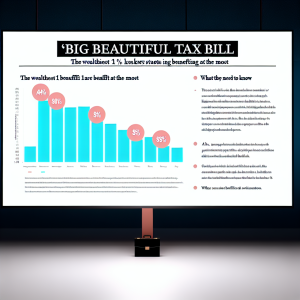The Trump Tax Cuts 2.0: A Wealth Windfall with a Geographic Twist Investors Can’t Ignore
A seismic tax overhaul, championed by former President Trump and now on the brink of final House approval, promises to reshape the financial landscape for America’s wealthiest—but with a twist that savvy investors and advisors need to understand deeply. According to a fresh analysis from the Institute on Taxation and Economic Policy (ITEP), this massive tax cut package could hand the top 1% of U.S. households an average tax break of $66,000 in 2026. Yet, the real story lies in where these affluent households reside, with some states poised for outsized gains while others face more modest benefits.
The Geography of Wealth and Tax Relief: Why Location Matters More Than Ever
ITEP’s data reveals a striking geographic disparity: the richest 1% in Wyoming, South Dakota, and Texas stand to slash their tax bills by more than $100,000 annually—Wyoming’s elite could see reductions averaging $133,000, about 3% of their income. Why? These states combine high concentrations of ultra-wealthy residents with minimal or no state income taxes, making them prime beneficiaries of the bill’s provisions.
Carl Davis, ITEP’s research director, underscores this point: “The bill is most advantageous to conservative-leaning states that have a lot of very wealthy people living within their borders.” This isn’t just about raw income but how state tax regimes interact with federal cuts. The bill’s cap on state and local tax (SALT) deductions—set at $40,000—hits high-tax states like California and New Jersey hardest. There, the wealthiest see average cuts of only $34,000 and $21,000 respectively, roughly 1% of their income.
What Investors and Advisors Need to Know: Beyond the Headlines
The legislation extends the 2017 tax cuts, lowers income tax rates, expands estate tax exemptions, and offers business tax breaks—moves that disproportionately favor high earners. But here’s the kicker: the bill also slashes billions from social safety net programs such as Medicaid and SNAP, which predominantly support lower-income Americans. Analyses from Yale’s Budget Lab and the Congressional Budget Office warn that when these cuts are factored in, the lowest earners could actually be worse off despite modest tax relief.
For investors and financial advisors, this bifurcation signals a pivotal moment. Wealthy clients in low-tax states stand to gain substantially, potentially freeing up capital for reinvestment, business expansion, or estate planning. Conversely, those in high-tax states may need to recalibrate expectations and strategies, especially considering the SALT cap’s impact.
Actionable Insights: What Should You Do Now?
-
Reassess Geographic Tax Exposure: High-net-worth clients should evaluate the tax efficiency of their state residency. The stark contrasts between states like Texas and California may prompt discussions about domicile planning—a strategy that could yield significant tax savings.
-
Estate and Business Planning Opportunities: With increased estate tax exemptions and business tax breaks, now is the time to revisit estate plans and business structures. Advisors should explore trusts, gifting strategies, and entity reorganizations to maximize benefits.
-
Prepare for Social Safety Net Cuts: For clients with philanthropic goals or those invested in social impact, anticipate shifts in government support programs. This may open avenues for increased private sector or charitable involvement to fill gaps.
-
Monitor Legislative Developments: The bill’s passage is imminent, but political dynamics remain fluid. Stay informed on potential amendments or related policy changes that could alter the tax landscape.
A Unique Perspective: The Texas Effect and Its Ripple
Consider Texas, where the top 1% earn an average of $3.8 million annually. The projected $100,000+ tax cut there isn’t just a headline number—it could fuel a wave of reinvestment in local economies, startups, and real estate. Early indicators from recent IRS data show an uptick in capital gains realizations in Texas post-legislation announcement, suggesting that wealthy taxpayers are already positioning to capitalize on the new tax environment.
Forecast: What’s Next for Investors?
Expect a growing divide in wealth accumulation trajectories based on geography. Low-tax states will likely attract more affluent individuals and entrepreneurs seeking tax efficiency, potentially driving up asset prices and investment opportunities in these regions. Meanwhile, high-tax states may face pressure to reconsider their tax policies or risk capital flight.
In conclusion, the Trump tax cut package is not just a policy change—it’s a catalyst reshaping the financial strategies of America’s wealthiest. For extreme investors and advisors, understanding the interplay of federal cuts, state tax regimes, and social program reductions is critical to navigating this new terrain successfully. Stay ahead by integrating geographic tax planning, revisiting estate and business strategies, and anticipating the broader economic shifts this legislation will provoke.
Sources: Institute on Taxation and Economic Policy (ITEP), Tax Policy Center, Yale Budget Lab, Congressional Budget Office, IRS recent capital gains data.
Source: Trump ‘big beautiful’ bill gives top 1% biggest tax cuts in these states

